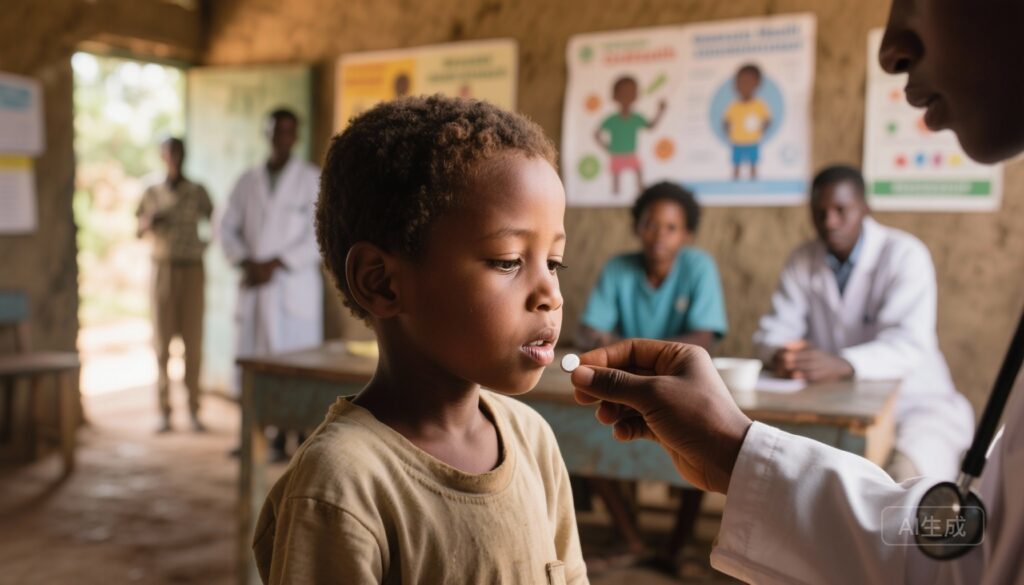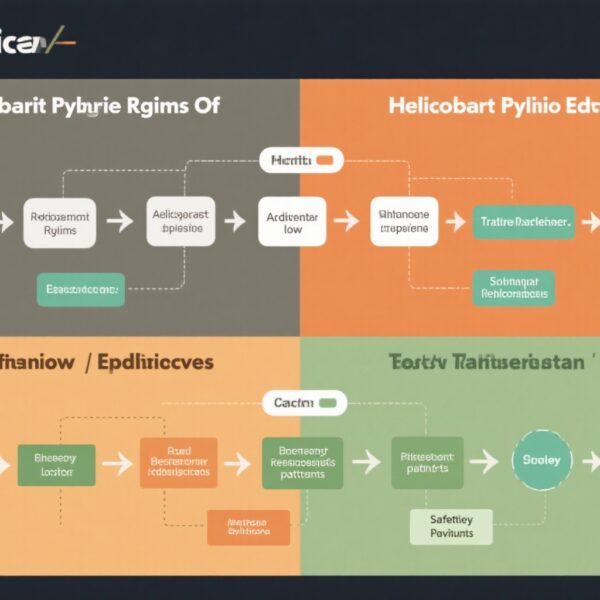Highlights
• An orodispersible ivermectin formulation co‑administered with albendazole produced a clear, incremental dose–response in cure rates for Trichuris trichiura in children aged 2–5 years, reaching a predicted 90.9% cure at 400 μg/kg.
• Moxidectin (age‑adjusted single dose) plus albendazole was significantly more effective than albendazole alone in school‑aged children (69% vs 16% cure), with similar safety to control.
• Both combination strategies were well tolerated; adverse events were predominantly mild, transient, and similar in frequency across active and control groups.
Background and disease burden
Trichuris trichiura (whipworm) is a common soil‑transmitted helminth (STH) responsible for substantial morbidity in children in low‑resource settings. Heavy or chronic infections can impair growth, iron status, and cognitive development, perpetuating a cycle of poverty and poor educational attainment. Current standard single‑dose anthelmintic therapies—most commonly albendazole or mebendazole—have limited efficacy against T. trichiura. Combination regimens and alternative anthelmintics have therefore been priorities for both clinical management and preventive chemotherapy (mass drug administration, MDA).
Historically, ivermectin and moxidectin have been used in other neglected tropical diseases (NTDs) such as onchocerciasis and scabies. Emerging evidence suggests additive or synergistic activity when these macrocyclic lactones are co‑administered with albendazole against T. trichiura. However, data in young children (<6 years) have been sparse, and formulations suitable for preschoolers (eg, orodispersible tablets) have been lacking.
Study designs and populations
Orodispersible ivermectin dose‑ranging, phase 2 (Pemba Island)
This single‑blind, randomized, parallel‑group, dose‑ranging, phase 2 trial enrolled children aged 2–5 years on Pemba Island, Tanzania. Screening used quadruplicate Kato‑Katz thick smears; inclusion required at least two positive slides. Participants (n=260 randomized; full analysis set n=245 with primary outcome data) were allocated 1:1:1:1:1:1 to placebo+albendazole 400 mg; orodispersible ivermectin at 100, 200, 300, or 400 μg/kg each plus albendazole 400 mg; or standard ivermectin tablets 200 μg/kg plus albendazole 400 mg. Allocation was computer‑generated (block sizes of six) and stratified by age and infection intensity. Outcomes were assessed 14–21 days post‑treatment. The primary endpoint was parasitological cure (conversion from egg‑positive to egg‑negative by Kato‑Katz). The ivermectin dose–response was modeled using a hyperbolic Emax curve. Safety was recorded at 3 hours, 24 hours, and 14–21 days post dose. Trial registration: NCT06184399.
Moxidectin–albendazole superiority trial, phase 3 (Pemba Island)
This randomized, double‑blind, parallel‑group, superiority, phase 3 trial enrolled school‑aged children (6–11 years) at a primary school in Pemba Island. After quadruplicate Kato‑Katz screening with ≥2 positive slides, eligible participants (n=224 randomized; n=213 with primary outcome data) were randomized 3:2:1 to moxidectin (4 mg for 6–7 years; 8 mg for 8–11 years) plus albendazole 400 mg, albendazole 400 mg alone (with moxidectin placebo), or double placebo. The primary endpoint was cure at 14–21 days post‑treatment; safety assessments paralleled the ivermectin trial. Trial registration: NCT06188715.
Key findings
Efficacy — preschoolers: orodispersible ivermectin + albendazole
The Emax dose–response model predicted that even the lowest orodispersible ivermectin dose (100 μg/kg) plus albendazole produced substantially higher cure rates than albendazole alone: predicted cure 54.2% (95% CI 41.1–66.7; observed 21/42 cured) versus placebo+albendazole 16.7% (95% CI 8.2–31.0; 7/40 cured). Cure rates rose across ascending doses in a near‑monotonic fashion, reaching a predicted cure of 90.9% (95% CI 81.8–95.7; observed 36/40 cured) with 400 μg/kg orodispersible ivermectin plus albendazole. These results indicate a pronounced dose–response and suggest that higher ivermectin doses are both more efficacious and potentially transformative for management of trichuriasis in the preschool age group.
Efficacy — school‑aged: moxidectin + albendazole
The moxidectin–albendazole combination produced a cure rate of 69% (77/111) at 14–21 days versus 16% (11/68) for albendazole alone (absolute difference 53.2 percentage points; 95% CI 39.6–64.2). The placebo group had a 12% cure rate (4/34). The superiority design and the large absolute difference support moxidectin–albendazole as a more effective single‑dose combination for school‑aged children in this setting.
Safety
Both trials reported predominantly mild and transient adverse events. In the orodispersible ivermectin study the most common treatment‑emergent event was abdominal pain with similar frequencies across groups: 7% in the 100 μg/kg group (3/44), 2% in 200 μg/kg (1/42), 2% in 300 μg/kg (1/44), 5% in 400 μg/kg (2/44); 7% in placebo+albendazole (3/43); and 2% in standard ivermectin+albendazole (1/43). In the moxidectin trial abdominal pain and headache were the most frequent events and were generally mild: abdominal pain occurred in 4% of the moxidectin–albendazole group (5/114), 3% of albendazole alone (2/74), and 3% of placebo (1/36); headache was reported in two participants (2%) in the combination arm and in one placebo participant. No unexpected safety signals were described, and the authors concluded a dose‑independent safety profile for orodispersible ivermectin within the tested range.
Interpretation and clinical implications
Collectively, these trials provide robust, contemporary evidence that combining a macrocyclic lactone (ivermectin or moxidectin) with albendazole markedly improves cure rates for T. trichiura compared with albendazole alone, across two pediatric age strata. The orodispersible ivermectin formulation addresses a crucial practical barrier for preschoolers who cannot reliably swallow tablets. The observed dose–response up to 400 μg/kg suggests potential to optimize dosing in young children to approach cure rates near 90% without compromising tolerability.
Moxidectin–albendazole yielded a large absolute benefit in school‑aged children and may offer a simpler programmatic option where age‑adjusted fixed dosing is feasible. Moxidectin’s longer half‑life relative to ivermectin could have theoretical advantages for sustained suppression of egg production, though this requires mechanistic and longer‑term reinfection data.
Limitations and considerations
Key limitations to bear in mind when translating results into policy or practice include:
- Short follow‑up (14–21 days): Cure by egg clearance is an early outcome and does not capture longer‑term reinfection dynamics or recurrence of egg output. MDA impact requires sustained suppression of transmission and repeated rounds.
- Diagnostic sensitivity: Kato‑Katz is standard in trials but has limited sensitivity for low‑intensity infections; some residual infections may have been missed.
- Generalisability: Both trials were conducted on Pemba Island in Tanzania, a high‑prevalence setting; efficacy may vary with local transmission intensity, nutritional status, and coinfections.
- Sample size and age strata: The phase 2 ivermectin dose‑finding trial included modest numbers per dose group. Larger phase 3 trials will be necessary to confirm efficacy and safety, especially for the highest pediatric dose.
- Pharmacokinetics and drug interactions: Pediatric pharmacokinetic data for high‑dose ivermectin in toddlers and for moxidectin in younger children remain limited; age‑specific absorption and metabolism could affect both safety and efficacy.
Programmatic and policy implications
If subsequent phase 3 and programmatic studies confirm these findings, several implications follow:
- Inclusion of orodispersible ivermectin–albendazole for preschool children in national STH control programs could reduce morbidity in an age group often excluded from school‑based MDA.
- Moxidectin–albendazole may be prioritized for school‑based MDA where regulatory approval and supply chains allow, given a single fixed dose strategy and demonstrated superiority.
- Operational research will be needed on co‑administration with other NTD drugs, integration into existing MDA platforms, cost‑effectiveness, community acceptability, and supply‑chain readiness.
- Guideline committees (eg, WHO) will require phase 3 evidence, safety data in younger age groups, and pharmacovigilance plans before recommending changes to preventive chemotherapy policies.
Expert commentary and next steps
These trials—carefully conducted in a high‑burden setting and reporting clinically meaningful effect sizes—advance the field in two ways. First, they demonstrate that formulation science (orodispersible ivermectin) can make potent drugs accessible to preschool children. Second, they expand the therapeutic armamentarium with convincing evidence for moxidectin combinations in school‑aged children.
Priority next steps include larger, multicenter phase 3 trials to confirm efficacy and safety across epidemiologic contexts; pharmacokinetic studies in infants and toddlers for dose optimization; longer follow‑up to assess reinfection and impact on egg reduction rates and morbidity; and programmatic pilots to test integration into routine MDA schedules.
Conclusion
Two contemporary randomized trials from Pemba Island show that combination therapy with a macrocyclic lactone plus albendazole markedly improves cure rates for T. trichiura in children. An orodispersible ivermectin formulation produced a clear dose‑dependent increase in cure in preschoolers, with predicted cure of ~91% at 400 μg/kg and acceptable tolerability. Moxidectin–albendazole was superior to albendazole monotherapy in school‑aged children (69% vs 16% cure). These data support accelerated development toward phase 3 evaluation and, if confirmed, careful consideration of inclusion in STH control strategies, particularly to reach younger children not covered by school‑based programs.
Funding and trial registration
Both trials were funded by the Swiss National Science Foundation. Trial registrations: orodispersible ivermectin study NCT06184399; moxidectin–albendazole study NCT06188715.
References
1) Sprecher VP, Schnoz A, Biendl S, Hussein HS, Najim SO, Ali MN, Mohammed IS, Ali SM, Hattendorf J, Keiser J. Efficacy and safety of ascending doses of orodispersible ivermectin co‑administered with albendazole for Trichuris trichiura infections in preschool‑aged children in Tanzania: a single‑blind, randomised, controlled, dose‑ranging, phase 2 trial. Lancet Infect Dis. 2025 Sep 17: S1473‑3099(25)00472‑4. doi:10.1016/S1473‑3099(25)00472‑4. PMID: 40975108.
2) Schnoz A, Sprecher VP, Biendl S, Hussein HS, Najim SO, Ali MN, Mohammed IS, Ali SM, Hattendorf J, Keiser J. Efficacy and safety of moxidectin‑albendazole combination therapy for Trichuris trichiura infections in school‑aged children: a double‑blind, randomised, controlled, superiority trial. Lancet Infect Dis. 2025 Dec;25(12):1325‑1335. doi:10.1016/S1473‑3099(25)00344‑5. PMID: 40675166. Erratum: Lancet Infect Dis. 2025 Sep;25(9):e497. doi:10.1016/S1473‑3099(25)00475‑X.
3) World Health Organization. Preventive chemotherapy to control soil‑transmitted helminth infections in at‑risk population groups. WHO Guideline. 2017. (WHO Library cataloguing‑in‑publication data).
Further reading and implementation guidance should reference WHO preventive chemotherapy policies and upcoming guideline updates as phase 3 data become available.



